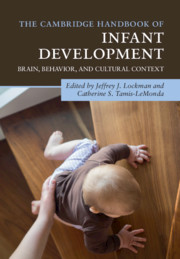Book contents
- The Cambridge Handbook of Infant Development
- The Cambridge Handbook of Infant Development
- Copyright page
- Dedication
- Contents
- Illustrations
- Contributors
- Preface
- Part I Foundations
- Part II Perceptual Development
- Part III Cognitive Development
- Part IV Action
- Part V Language
- 21 Infant Speech Perception
- 22 Infant Vocal Learning and Speech Production
- 23 Infant Word Learning and Emerging Syntax
- 24 Dual Language Exposure and Early Learning
- Part VI Emotional and Social Development
- Index
- References
21 - Infant Speech Perception
from Part V - Language
Published online by Cambridge University Press: 26 September 2020
- The Cambridge Handbook of Infant Development
- The Cambridge Handbook of Infant Development
- Copyright page
- Dedication
- Contents
- Illustrations
- Contributors
- Preface
- Part I Foundations
- Part II Perceptual Development
- Part III Cognitive Development
- Part IV Action
- Part V Language
- 21 Infant Speech Perception
- 22 Infant Vocal Learning and Speech Production
- 23 Infant Word Learning and Emerging Syntax
- 24 Dual Language Exposure and Early Learning
- Part VI Emotional and Social Development
- Index
- References
Summary
Human infants are born well prepared to acquire language, with impressive speech perception abilities well before the onset of productive language. Over the first years of life, these perceptual capacities are tuned to the native language. Rich social experience interacts with intrinsic neurobiological systems to scaffold perceptual abilities that support language acquisition. At birth – indeed, as early as 26 weeks gestation, prior to input from developing auditory pathways – the basic neural architecture is in place for processing language. Experience and further development lead to an elaboration and refinement of this architecture. At birth, perceptual biases are in place that predispose infants to listen more attentively when they hear speech and to look toward human faces – two core communicative sensitivities that lay the foundation for acquiring the native language. A variety of learning mechanisms are operative that enable infants to become experts at perceiving and ultimately producing their native language(s).
Keywords
- Type
- Chapter
- Information
- The Cambridge Handbook of Infant DevelopmentBrain, Behavior, and Cultural Context, pp. 579 - 601Publisher: Cambridge University PressPrint publication year: 2020



